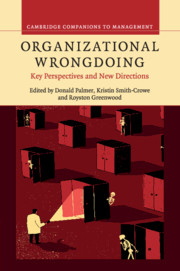Book contents
- Frontmatter
- Contents
- List of figures
- List of tables
- List of contributors
- Foreword
- 1 The imbalances and limitations of theory and research on organizational wrongdoing
- 2 On taking the theoretical substance of outcomes seriously: a meta-conversation
- 3 Wrong paths to right: defining morality with or without a clear red line
- 4 From market enablers to market participants: redefining organizational and political-legal arrangements and opportunities for financial wrongdoing,1930s–2000
- 5 Wrongdoing and market development: an examination of the distinct roles of trust and distrust
- 6 Bad apples, bad barrels and bad cellars: a “boundaries” perspective on professional misconduct
- 7 S/he blinded me with science: the sociology of scientific misconduct
- 8 Social networks and organizational wrongdoing in context
- 9 Falling stars: celebrity, infamy, and the fall from (and return to) grace
- 10 Compensation and employee misconduct: the inseparability of productive and counterproductive behavior in firms
- 11 Beware of organizational saints: how a moral self-concept may foster immoral behavior
- 12 “Is it me? Or is it me?” The role of coactivated multiple identities and identifications in promoting or discouraging workplace crimes
- 13 Consequences of organizational misconduct: too much and too little punishment
- 14 Who bears the brunt? A review and research agenda for the consequences of organizational wrongdoing for individuals
- 15 Organizational wrongdoing and media bias
- 16 Ethical learning: releasing the moral unicorn
- Index
- References
5 - Wrongdoing and market development: an examination of the distinct roles of trust and distrust
Published online by Cambridge University Press: 05 July 2016
- Frontmatter
- Contents
- List of figures
- List of tables
- List of contributors
- Foreword
- 1 The imbalances and limitations of theory and research on organizational wrongdoing
- 2 On taking the theoretical substance of outcomes seriously: a meta-conversation
- 3 Wrong paths to right: defining morality with or without a clear red line
- 4 From market enablers to market participants: redefining organizational and political-legal arrangements and opportunities for financial wrongdoing,1930s–2000
- 5 Wrongdoing and market development: an examination of the distinct roles of trust and distrust
- 6 Bad apples, bad barrels and bad cellars: a “boundaries” perspective on professional misconduct
- 7 S/he blinded me with science: the sociology of scientific misconduct
- 8 Social networks and organizational wrongdoing in context
- 9 Falling stars: celebrity, infamy, and the fall from (and return to) grace
- 10 Compensation and employee misconduct: the inseparability of productive and counterproductive behavior in firms
- 11 Beware of organizational saints: how a moral self-concept may foster immoral behavior
- 12 “Is it me? Or is it me?” The role of coactivated multiple identities and identifications in promoting or discouraging workplace crimes
- 13 Consequences of organizational misconduct: too much and too little punishment
- 14 Who bears the brunt? A review and research agenda for the consequences of organizational wrongdoing for individuals
- 15 Organizational wrongdoing and media bias
- 16 Ethical learning: releasing the moral unicorn
- Index
- References
Summary
Research on organizational wrongdoing has grown considerably in recent years. The focus of most recent work on wrongdoing is on better understanding the causes of organizational malfeasance and detecting its occurrence. This focus is understandable, as organization theorists are primarily interested in influences on organizational behavior that incentivize corrupt practices (for a review, see Greve, Palmer, and Pozner 2010), and a core interest of accounting scholars is the detection of corrupt practices such that stakeholders can more easily identify and punish deviant behavior (e.g., Cecchini et al. 2010; Corona and Randhawa 2010).
In this chapter, I explore an understudied aspect of organizational wrongdoing: victims’ reactions to it. Specifically, I am interested in the effects of organizational wrongdoing on market participation and thus market development. Market forms of exchange in contemporary societies are underpinned by trust, but given that wrongdoing is a common feature of economic and social life (Palmer 2012), we need a better understanding of whether, to what extent, and why malfeasance affects the actors’ willingness to continue to participate in a market after being a victim of malfeasance. Earlier work from multiple disciplines has demonstrated negative effects of wrongdoing for the firms that commit it (Baucus and Baucus 1997; Palmrose, Richardson, and Scholz 2004; Sharkey 2014), the markets in which they are situated (Mauro 1995; Wei 2000), and the states that appear inadequate for protecting against it (Easterly, Ritzen, and Woolcock 2006; La Porta et al. 1997; Zak and Knack 2001). I follow these latter lines of work by addressing the effects of misconduct in emerging markets, but I depart from their macro-level measurement of outcomes to theorize about variation in individual-level reactions. Building market institutions in developing countries depends upon actors’ willingness to participate, and much earlier work has highlighted the central role of trust in fostering participation (Woolcock 1998; Zak and Knack 2001; Zucker 1986). But we also know that trust-damaging fraud and corruption are especially common features in developing contexts; thus, studying the effects of misconduct on individuals’ continued participation in developing markets provides a valuable way to expand theory linking trust to market participation and development.
Information
- Type
- Chapter
- Information
- Organizational WrongdoingKey Perspectives and New Directions, pp. 114 - 140Publisher: Cambridge University PressPrint publication year: 2016
References
Accessibility standard: Unknown
Why this information is here
This section outlines the accessibility features of this content - including support for screen readers, full keyboard navigation and high-contrast display options. This may not be relevant for you.Accessibility Information
- 4
- Cited by
